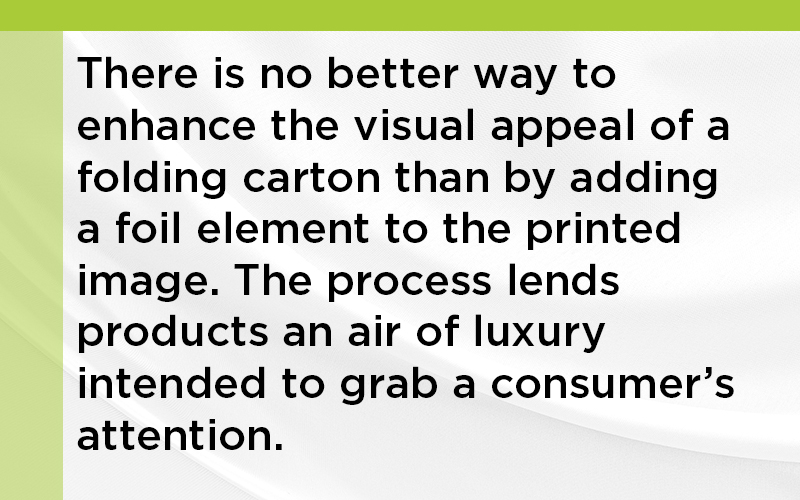
By Chris Raney, Heidelberg USA
There is no better way to enhance the visual appeal of a folding carton than by adding a foil element to the printed image. The process lends products an air of luxury intended to grab a consumer’s attention. Hot foil stamping substantially ups the ante by creating a pleasing visual and tactile experience that is the result of combining relief and textured embossing with the application of foil in a single pass.
The application of colored foil or holographic design produces a special bond between the substrate and the foil, producing an exceptional shine. Embossing elements lend the substrate a multidimensional look and feel. Typical applications include packaging for high-quality consumer goods such as chocolates or perfumes.
Traditionally a time-consuming and expensive process, improvements enabling efficient foil usage and faster makeready times have increased the competitiveness of hot foil stamping as the ultimate way to enhance a printed image. Below, a few things to keep in mind:
Waste Not: All hot foil stamping machines offer “step-and-repeat” solutions designed to optimize the efficient use of costly foil in job layouts. Generally speaking, however, it’s not possible to use foils widths less than 2″ wide, meaning there are limitations on how closely different colors can be placed next to each other. Multiple machine passes can be used to obtain the required final effect; however, in addition to considering the cost of re-running sheets through the machine, converters also must take into account the accuracy of the registration that can be achieved. Take care not to create such a challenging design that the resulting waste levels make the product uncompetitive in the market.
Hot Stuff: Accurate makeready and careful control of heat across the different areas of the sheet will ensure perfect laydown and a superior mirror effect, unmatched by competing processes like cold foil or metallic inks. It is also possible to run combination foil stamping and embossing dies for the ultimate in reflectiveness and relief effects.
To Die For: Consider carefully some of the recent innovations in die positioning technology to save time during stamping die makeready. Traditionally, embossing dies are mounted onto a honeycomb plate when cold. Considerable experience is required to do this accurately and to compensate for the expansion the dies will undergo when the machine is at operating temperature. Available today are several solutions that combine an image of the embossing dies on the honeycomb with a PDF file of the job. With the use of sophisticated heat expansion modeling, the two can be overlaid accurately, ensuring perfect registration of the embossing dies to the printed sheets.
Chris Raney is vice president, packaging at Heidelberg USA, Kennesaw, GA. A leading solution provider for the print media industry, Heidelberg manufactures precision printing presses, platesetters, postpress equipment and software for integrating all printshop processes. For more information, call 770.419.6500 or visit www.us.heidelberg.com.

